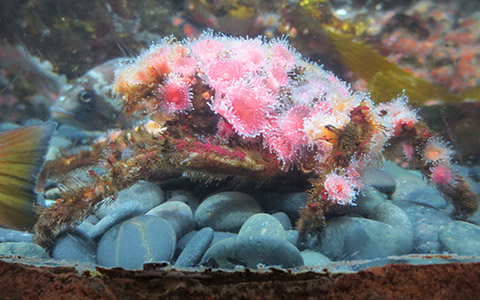If you've ever been diving or visited an aquarium and seen something resembling a walking plant, look closer-there just might be a crab under there.

Decorator crabs use small hairs on their shells, called setae, to cover themselves with some very unique accessories. Photo courtesy of Aquarium of the Bay
By Mallory Johnson
Published: November, 2016
If you’ve ever been diving or visited an aquarium and seen something resembling a walking plant, look closer—there just might be a crab under there. Decorator crabs are also known as masking crabs or moss crabs, the latter name best describing them while they are au naturel.
The backs of decorator crabs’ shells are covered in short hairs, called setae, giving these crabs the appearance of being covered in moss. They don’t stay like this for long though, instead opting for a more festive look. The setae along their shells are actually hooked, giving the shell a Velcro-like quality. Decorator crabs use their setae to cover themselves with some very unique accessories.
These crafty crustaceans use their setae to adorn their shells with various items from their surroundings, including seaweed, anemones, sponges and bryozoans. This gives them a unique form of camouflage, allowing them to blend into various parts of their environment to avoid pesky predators. Another advantage to these decorations is that they can double as a meal. Decorator crabs tend to feast on algae, sponges and bryozoans, the same items they embellish themselves with—meaning they don’t necessarily have to go far to find their next meal.
There’s another smart lesson we can learn from these clever crabs, who are not only keen decorators but resourceful as well. During the molting process, decorator crabs will shed their old exoskeleton to make way for a new, larger one. Once they replace their shells, they need to redecorate to continue to hide from predators. Instead of starting from scratch, however, they recycle their thrifty decorations by taking the anemones and other items off of their old shells and reusing them on the new ones.
Decorator crabs generally only accessorize their shells during their juvenile stages, while they are still small and more vulnerable to predators. As they mature, they are less threatened by other species and therefore no longer feel the need to get dressed up to go out. This doesn’t always stop others from taking on the job for them, though. With their hooked setae being so effective, other plants and animals simply latch themselves onto their shells and go along for the ride.
You can learn more about decorator crabs when you visit Aquarium of the Bay, and see if you can spot these cleverly disguised crustaceans walking around in our tanks while you’re there. Visit www.aquariumofthebay.org
for more information.

